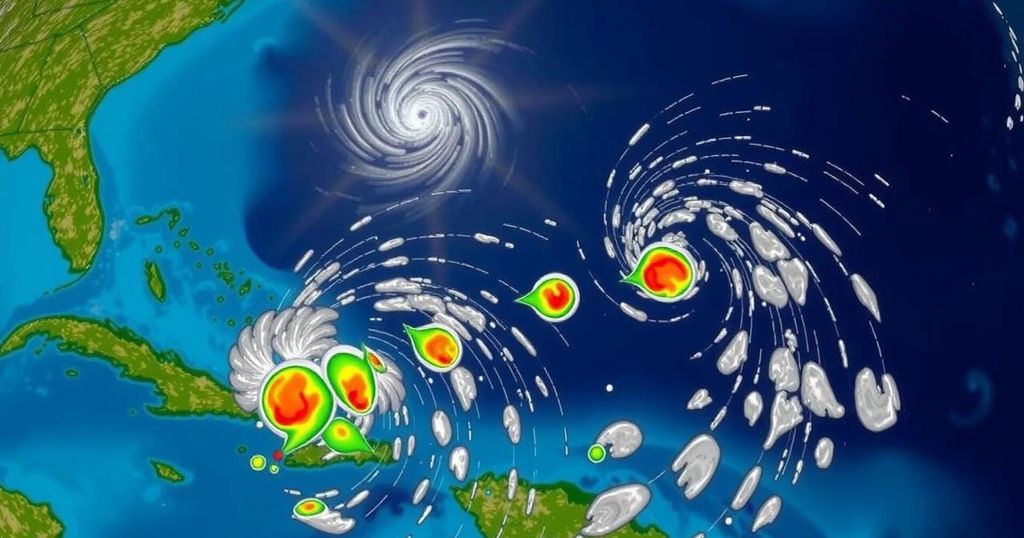Weather
World news
AFRICA, ARKANSAS DEMOCRAT GAZETTE, ASHEVILLE, ATLANTIC, BE, BERMUDA, BRIAN MCNOLDY, CARRIACOU, CUBA, DOMINICAN REPUBLIC, EUROPE/ASIA, EVACUATIONS, FLORIDA, GEORGIA, GRENADA, GULF COAST, GULF OF MEXICO, HELENE, HURRICANE, HURRICANE SEASON, JAMAICA, KATE, NATIONAL HURRICANE CENTER, NATURAL DISASTER, NATURAL DISASTERS, NORTH AMERICA, NORTH CAROLINA, ORLANDO, RAFAEL, SOUTH AFRICA, SOUTH CAROLINA, TAMPA, TENNESSEE, U. S, U. S. GULF COAST, UNITED STATES, UNIVERSITY OF MIAMI, VIRGINIA
Daniel O'Connor
0 Comments
2024 Hurricane Season Concludes with Unprecedented Storm Activity
The 2024 Atlantic hurricane season concluded with 11 hurricanes, surpassing the average of seven, attributed to warm ocean temperatures. Significant storms included Hurricane Beryl and Helene, with notable destruction across the southeastern U.S. and record rainfall reported. Experts attribute increased storm activity to climate change influences.
The 2024 Atlantic hurricane season officially concluded on Saturday, culminating in an unprecedented total of 11 hurricanes, surpassing the average of seven. This season was branded as “crazy busy” by meteorologists, significantly influenced by unusually high ocean temperatures. A total of eight hurricanes made landfall across the U.S., Bermuda, Cuba, the Dominican Republic, and Grenada.
Noteworthy was Hurricane Beryl, which marked the first Category 4 hurricane ever recorded in June, striking Grenada and subsequently wreaking havoc in Jamaica, resulting in crop damage and fatalities. Beryl subsequently escalated to the earliest Category 5 hurricane in recorded history on July 1, a period when significant hurricanes are not typically anticipated until September.
Hurricane Helene emerged in September, proving to be the most deadly storm to impact the U.S. mainland since Hurricane Katrina in 2005, with a staggering death toll exceeding 200 people. The state of North Carolina alone estimated damages reaching at least $48.8 billion, with extensive destruction of homes, agricultural lands, and essential infrastructure across multiple states.
In October, the rapid intensification of Hurricane Milton was highlighted, with wind speeds soaring to 180 mph, classifying it amongst the strongest hurricanes recorded in the Gulf of Mexico. Rainfall during this period reached unprecedented levels, with Asheville, Tampa, and Orlando experiencing the wettest two-month interval on record.
November concluded the season with Hurricane Rafael, which approached the status of the strongest November hurricane in the Gulf, causing further hardship in Cuba still grappling with the aftermath of Hurricane Oscar. The intensified hurricane activity has been attributed to climate change, particularly the warming of ocean waters resulting from greenhouse gas emissions. As noted by Brian McNoldy, a hurricane researcher, while one cannot directly link specific storms to climate change, its influence makes the occurrence of extreme storms more probable, exemplifying the unusual storm patterns observed this season.
The Atlantic hurricane season extends from June 1 to November 30 annually, during which the storms form over warm ocean waters. Meteorological patterns, ocean temperature, and atmospheric conditions play crucial roles in tropical cyclone development. The historical average for a hurricane season includes a lesser number of hurricanes, establishing a point of reference to understand the atypical nature of 2024’s season. Recent discussions in climatology suggest that climate change is influencing the severity and frequency of such storms, leading to increased rainfall, rapid intensification, and extended hurricane activity into months that previously saw less tropical activity.
In summary, the 2024 Atlantic hurricane season has left a significant mark, with an elevated count of hurricanes and devastating impacts across multiple states and territories. Factors such as rising ocean temperatures driven by climate change are believed to have contributed to this unusual activity, highlighting a new era of more frequent and intense tropical storms. As storm patterns evolve, the implications for preparedness and response strategies become ever more crucial for vulnerable regions.
Original Source: www.arkansasonline.com




Post Comment